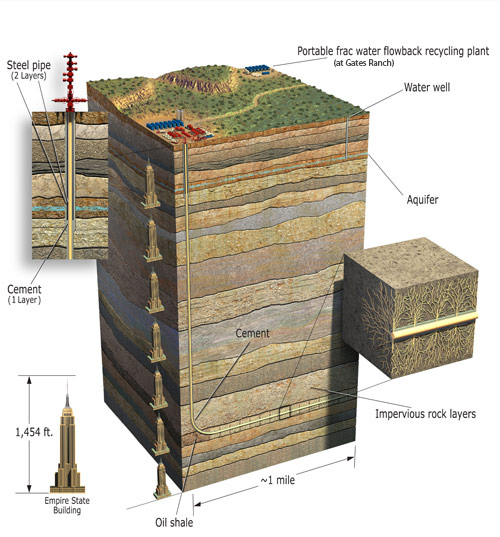Share:
WHAT IS HYDRAULIC FRACTURING
Contrary to many media reports, hydraulic fracturing is not a “drilling process.” Hydraulic fracturing is used after the drilled hole is completed. Put simply, hydraulic fracturing is the use of fluid and material to create or restore small fractures in a formation in order to stimulate production from new and existing oil and gas wells. This creates paths that increase the rate at which fluids can be produced from the reservoir formations, in some cases by many hundreds of percent.
The process includes steps to protect water supplies. To ensure that neither the fluid that will eventually be pumped through the well, nor the oil or gas that will eventually be collected, enters the water supply, steel surface or intermediate casings are inserted into the well to depths of between 1,000 and 4,000 feet. The space between these casing “strings” and the drilled hole (wellbore), called the annulus, is filled with cement. Once the cement has set, then the drilling continues from the bottom of the surface or intermediate cemented steel casing to the next depth. This process is repeated, using smaller steel casing each time, until the oil and gas-bearing reservoir is reached (generally 6,000 to 10,000 ft). A more detailed look at casing and its role in groundwater protection is available on the FracFocus website.

With these and other precautions taken, high volumes of fracturing fluids are pumped deep into the well at pressures sufficient to create or restore the small fractures in the reservoir rock needed to make production possible.
More detailed information on Hydraulic Fracturing is available on www.FracFocus.org.
News
- GWPC Provides Comments to EPA on Louisiana Class VI UIC Program Revision Application
- US Produced Water Volumes & Management Practices in 2021
- RBDMS WellFinder Adds Kansas Data
- Updated State Guide Addresses Seismicity Induced by Fluid Injection
- FracFocus Launches New Public Website
- California’s RBDMS 3.0: WellSTAR Release 4 Goes Live
Publications
- Modern Oil & Gas Development: 2023 Update
- 2023 State Oil & Natural Gas Regulations Designed to Protect Water Resources (Fourth Edition)
- Injection Wells: A Guide to Their Use, Operation, and Regulation (2021 Update)
- Potential Induced Seismicity Guide: A Resource of Technical and Regulatory Considerations Associated with Fluid Injection
- Well Integrity Regulatory Elements for Consideration: 2021 Edition
- State of Kansas Class II UIC Program Peer Review
- State of California Class II UIC Program Peer Review
- New Mexico Class II UIC Program Peer Review
- Produced Water Report: Regulations, Current Practices & Needs
- 2019 Exchange Peer Assessment: Colorado Well Integrity Regulations
- 2017 Revision: Potential Injection Induced Seismicity Associated With Oil & Gas Development: A Primer On Technical & Regulatory Considerations Informing Risk Management & Mitigation
- State Of West Virginia Class II UIC Peer Review
- State Oil And Natural Gas Regulations Designed To Protect Water Resources (3rd Edition)
- Underground Gas Storage Regulatory Considerations
- Ground Water Report to the Nation
- Ohio Class II Peer Review
- State Of Nebraska Class II UIC Program Peer Review
- State Of Utah Class II UIC Program Peer Review
- Potential Injection-Induced Seismicity Associated with Oil & Gas Development: A Primer on Technical and Regulatory Considerations Informing Risk Management and Mitigation
- State Oil And Gas Regulations Designed To Protect Water Resources